#wastewater storage
Explore tagged Tumblr posts
Text
Wastewater Processing Tanks in Pune - Efficient Solutions | Mizutanks"
Efficient wastewater management is essential for industrial and municipal applications. MizuTanks offers high-quality wastewater processing tanks in India, designed for durability, efficiency, and compliance with environmental standards. Our industrial wastewater tanks in India provide robust solutions for treating and storing wastewater effectively.
Why Choose MizuTanks for Wastewater Processing?
As a leading provider of advanced processing tanks, MizuTanks ensures that industries and municipalities get the most reliable wastewater storage solutions. Here’s why our Pune wastewater solutions are the best choice:
1. High-Quality Materials & Durability
Our steel bolted tanks are engineered for longevity, offering corrosion resistance and structural integrity to withstand harsh conditions.
2. Efficient Wastewater Treatment Solutions
We provide Wastewater Treatment Tanks that support various treatment processes, ensuring safe and effective wastewater management.
3. Customizable Capacities & Applications
MizuTanks offers ETP storage tanks, STP tanks, and effluent storage tanks tailored to different industrial and municipal requirements.
4. Compliance with Environmental Standards
Our wastewater processing tanks in India meet industry regulations, making them a reliable choice for sustainable wastewater management.
Applications of Wastewater Storage Tanks
Our wastewater processing tanks are widely used in:
Effluent Treatment Plants (ETP) – Safe storage of industrial wastewater before treatment.
Sewage Treatment Plants (STP) – Reliable solutions for municipal wastewater storage and processing.
Industrial Wastewater Management – Providing efficient storage and treatment of process water.
Chemical & Pharmaceutical Industries – Ensuring safe containment of hazardous and non-hazardous wastewater.
Trusted Wastewater Storage Solutions in India
MizuTanks is a trusted manufacturer of wastewater processing tanks in India, offering advanced processing tanks for industrial and municipal applications. Whether you need STP tanks, ETP storage tanks, or steel bolted tanks, we deliver the highest quality solutions tailored to your needs.
Contact Us Today
For the best wastewater storage and Pune wastewater solutions, reach out to MizuTanks. We are committed to providing top-quality industrial wastewater tanks in India that enhance wastewater treatment and storage efficiency.
#WastewaterProcessingTanks #MizuTanks #IndustrialWastewaterTanks #AdvancedProcessingTanks #WastewaterStorage #PuneWastewaterSolutions #WastewaterTreatmentTanks #EffluentStorageTanks #ETPStorageTanks #STPTanks #SteelBoltedTanks
https://mizutanks.com/pune/wastewater-processing-tanks.html
#Wastewater processing tanks in India#Mizutanks#industrial wastewater tanks in India#advanced processing tanks#wastewater storage#Pune wastewater solutions#Wastewater Treatment Tanks#effluent storage tanks#ETP storage tanks#STP tanks#steel bolted tanks
0 notes
Text
Top Water Storage Tank Supplier in India | Industrial, Agricultural & Firefighting Solutions
Reliable Water Storage Solutions in India – Commercial, Industrial & Agricultural Tanks
Water storage is essential for industries, agriculture, and municipal applications. Our high-quality commercial, industrial, and agricultural water storage tanks are designed for durability, efficiency, and long-term performance.
Our Storage Tank Solutions:
✔ Commercial & Industrial Storage Tanks – Ideal for manufacturing, processing, and raw water storage. ✔ Agricultural & Rainwater Tanks – Sustainable storage for irrigation and farming. ✔ Firefighting & Wastewater Tanks – FM-approved and corrosion-resistant solutions.
As a leading water storage tank supplier in India, we offer GFS tanks, FM-approved tanks, and zinc aluminium steel tanks.
#Commercial water storage tanks#Commercial water storage tanks in India#Agricultural water storage tanks#Agricultural water storage tanks in india#industrial storage tanks#industrial storage tanks in india#wastewater storage tanks#wastewater storage tanks in india#raw water storage tank#raw water storage tanks in india#firefighting storage tanks#firefighting storage tanks in india#rain water storage tanks#rain water storage tanks in india#process water storage tanks#process water storage tank in india#water storage tank supplier in india#GFS tank in india#FM approved tank#FM approved tank supplier in india#GFS tank supplier in india#Zinc aluminium steel tanks supplier#zinc aluminium steel tank supplier in india
0 notes
Text
Reliable Raw Water Storage Tanks – Prefab Tanks Dubai 💦🏗️
Looking for high-quality raw water storage tanks in Dubai, UAE, and Saudi Arabia? 🌍 Prefab Tanks Dubai offers durable and efficient water storage solutions for industrial, commercial, and municipal applications. Our steel bolted water tanks, epoxy-coated water tanks, and galvanized steel water tanks ensure maximum durability and corrosion resistance. ✅
Premium Raw Water Storage Tanks in Dubai & UAE 🚰🔩
✔️ Long-Lasting & Corrosion-Resistant – Our raw water storage tanks in Dubai-UAE are designed using epoxy-sealed steel and zinc-coated bolted steel to withstand harsh environmental conditions. ✔️ Versatile Applications – Suitable for industrial water treatment, irrigation, and municipal water supply. ✔️ Efficient Water Management – Our raw water containment tanks in Dubai-UAE help in sustainable water storage solutions. ✔️ Prefab Water Tanks in Dubai – Quick to install, easy to maintain, and customizable for different capacities.

Raw Water Storage Tanks in Saudi Arabia 🇸🇦💦
Prefab Tanks Dubai supplies raw water storage tanks in Saudi Arabia, ensuring reliable and long-lasting water storage solutions. Our bolted steel water tanks and epoxy-lined water storage tanks in UAE provide excellent protection against contamination and rust.
Advanced Water Storage Solutions 🚀🌊
🏗️ Water Treatment Tanks – Essential for filtration and purification systems. 🏗️ Effluent Treatment Tanks in UAE – Perfect for industrial wastewater treatment. 🏗️ Wastewater Storage Tanks in Saudi Arabia – Designed for safe and eco-friendly disposal. 🏗️ Epoxy-Coated Water Tanks – Ensuring hygienic and long-term water storage.
Trusted Prefab Tanks in Saudi Arabia & UAE ✅
As a leading supplier of raw water storage solutions in UAE, we provide custom-built, high-capacity tanks that meet global industry standards. Whether you need raw water containment tanks in Saudi Arabia, galvanized steel water tanks, or epoxy-sealed steel water tanks, we have the perfect solution!
💡 Explore More: 👉 Raw Water Storage Tanks – Prefab Tanks Dubai
🔹 Hashtags: #RawWaterStorage #WaterTanksDubai #PrefabTanksDubai #WaterStorageSolutions #SteelBoltedTanks #EpoxyCoatedTanks #ZincCoatedTanks #WastewaterTreatment 🚀💧
#Raw water storage tanks in Dubai#Raw water storage tanks#Raw water storage tanks in UAE#raw water storage tanks in Dubai-UAE#Prefabtanks in Dubai#Water Treatment Tanks#Steel Bolted Water Tanks#Epoxy Coated Water Tanks#Galvanized Steel Water Tanks#Prefabtanks in Saudi Arabia#Raw water storage tanks in Saudi Arabia#Raw water storage solutions in UAE#Raw water containment tanks in Dubai-UAE#Raw water containment tanks in Saudi Arabia#Effluent treatment tanks in UAE#Wastewater storage tanks in Saudi Arabia#Bolted steel water#Zinc-coated bolted steel water tanks in Saudi Arabia#Epoxy-lined water storage tanks in UAE#Epoxy-sealed steel water#water storage solutions in Saudi Arabia#Prefab water tanks in Dubai
0 notes
Text

Custom Metal Design and Manufacturing Services
Our platework steel fabrication methods utilize state-of-the-art machinery to ensure precision and consistency. Contact us now!
#custom steel tanks fabricator#chemical process tanks#fabricated tanks#settling tank wastewater treatment#custom industrial tanks#constructed steel process tanks#custom steel process tanks#platework steel fabrication#field erected storage tanks#stainless steel mixing tanks#stainless steel water tanks#stainless steel tank#stainless steel tanks
0 notes
Text
IWTV S2 filming locations
When I started putting the first version together last year, I never thought it would become an obsession and I would spend hours comparing wall patterns or searching for a non-existent street. But now I have the dubious privilege of being able to match almost every scene from S2 to where it was filmed (except for a few from episode 1, Emilia's village, where are you).
Season 2 was filmed mostly in and around Prague, mainly in the film studio at Barrandov and in Toušeň. In addition to that, they spent about two weeks in Paris and one shooting day in New Orleans.
Barrandov Studio – Atelier 8 / Paris Street backlot
The sets built inside the atelier were short-lived, but the outdoor backlot has been preserved and is used for other projects. Due to the studio's workload, it no longer offers public tours. But hopefully the situation will change in the future (x), (x).


Toušeň Ateliers
All the interior scenes of the Théâtre des Vampires were filmed here. The location is not open to the public and it was again only a temporary set, but as Mara mentioned, some of the pieces are still in storage somewhere and will probably be reused for S3 (x).


The production also rented some other locations for longer periods of time. Točník and its surroundings were used mainly for episode 1 (scenes with Daciana, the revenant in the forest), but also for episode 3 (Armand's coven in 1795). You can visit the castle.
They used the Old wastewater treatment plant in Bubeneč several times (all the scenes in the tunnels and sewers, Magnus's tower, Louis and Claudia's baboon argument, etc.). It is possible to book a tour there.

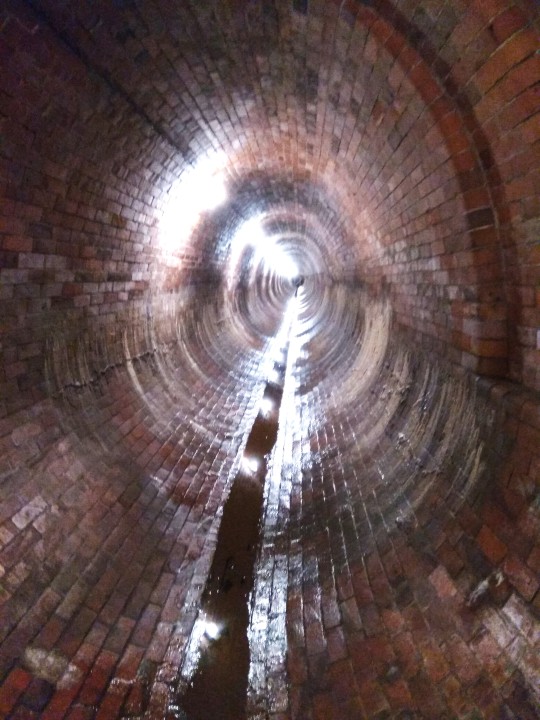
More than one scene was also filmed in Kinsky Garden (the bench in the rain, Louis and Dreamstat, Louis and Armand's first meeting).


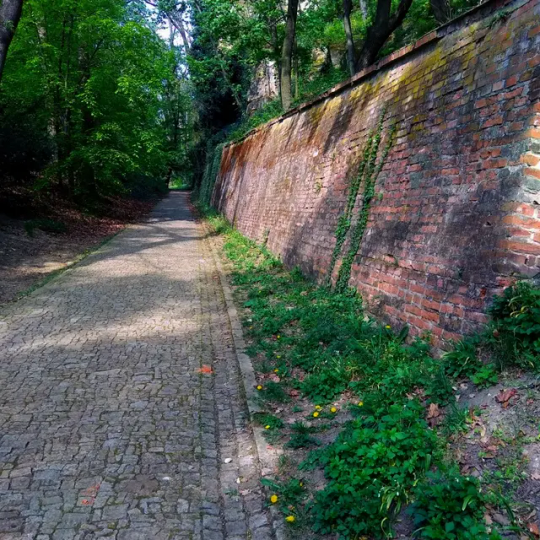
For the rest of the locations, check out the map.
.
.
Some comparisons of the scenes in the show with what the places normally look like.








129 notes
·
View notes
Text

Novel self-cleaning electrode developed for alkaline-earth metal peroxide synthesis
Metal peroxide (MO2, M=Ca, Sr, Ba) is an alternative to hydrogen peroxide (H2O2). It has excellent oxidative properties, superior chemical stability, high purity, and is easy to store and transport. It has been widely used in wastewater treatment and disinfection. A Chinese research group has developed a novel self-cleaning electrode by constructing a micro-/nanostructure of a highly active catalyst with appropriate surface modification, achieving highly stable synthesis of alkaline-earth MO2. Their study is published in Nature Nanotechnology. The current primary synthesis process of MO2 involves fast decomposition of H2O2, leading to insufficient utilization of H2O2. In this study, led by Prof. Lu Zhiyi at the Ningbo Institute of Materials Technology and Engineering (NIMTE) of the Chinese Academy of Sciences, in collaboration with Prof. Jia Jinping at Shanghai Jiaotong University, the researchers proposed an in situ electrochemical synthesis process to lessen economic losses and reduce explosion risks arising from H2O2 transportation and storage.
Read more.
8 notes
·
View notes
Text
The Los Angeles fires are already one of the most devastating disasters in California—and national—history. Fanned by high winds and fed by a prolonged drought, the blazes rapidly spread across thousands of acres in the nearby Santa Monica Mountains and into several neighborhoods. More than a week since the fires erupted, they have destroyed at least 5,000 homes and countless other structures, in addition to causing numerous deaths, evacuations, and other impacts. Costs are ballooning, with initial estimates reaching $50 billion or more—nearly five times the cost of the largest wildfire ever previously recorded.
While the visible destruction to homes, businesses, and livelihoods has understandably garnered most of the attention, the fires are also a reminder of the struggles to recognize and reinvest in the country’s water infrastructure.
Typically out of sight and out of mind before any disaster hits, the plants, pipes, reservoirs, and other systems responsible for treating, moving, and storing water are facing a variety of threats in Los Angeles and beyond. Immediate challenges became evident from a lack of water to help combat the rapidly spreading fires, with dry hydrants, depleted storage tanks, and drained reservoirs struggling to keep up. The Los Angeles Department of Water and Power (DWP)—the primary utility responsible for overseeing this infrastructure—faces soaring demand yet has few resources to respond, financially or otherwise. And these short-term impacts do not begin to touch all the long-term concerns around water quality and supply likely to emerge from the wildfire’s various byproducts and contamination.
As frustration and confusion mount alongside the fire’s damage, the finger-pointing has already started. The state has launched investigations into the fire’s cause, including the dry hydrants. Private lawsuits are hitting the DWP. And pundits and policymakers, including President-elect Donald Trump, are pushing different claims (and falsehoods) about the region’s water resources.
But the ultimate reality facing Los Angeles and the DWP—similar to many other communities and water utilities nationally—is one of underrecognized and underinvested infrastructure.
The city’s existing water infrastructure faced an impossible expectation—and task—as the historic fire spread. While Los Angeles has endured recent droughts and dry vegetation helped ignite the fire, water supply was not as much an issue as the infrastructure’s underlying design and function. The hydrants, pipes, and other systems were built to service ordinary residential, commercial, and industrial customers—not to combat unprecedented wildfires or other disasters. Simply operating and maintaining these systems represents a formidable challenge for utilities such as the DWP, which provides 163 billion gallons of water across 739,000 service connections annually.
Whether during a disaster or normal operating conditions, the DWP and other utilities too easily get ignored or blamed by policymakers, residents, and other stakeholders amid a lack of sustained, proactive investment to manage existing and evolving infrastructure needs. Nationally, more than $744 billion is needed to address all the various drinking water and wastewater improvements over the next two decades, from fixing leaking pipes to upgrading treatment plants. Los Angeles is just one piece in that complicated puzzle. Local utilities tend to not only be the primary owners and operators of all this infrastructure, but also the primary investors, responsible for more than three-quarters of all public water spending each year despite often lacking durable and predictable customer revenue, state support, and federal funding. When combined with increasingly extreme impacts fueled by climate change (including wildfires), these investment needs are only increasing over time.
Rather than being used to cast blame at underequipped and overwhelmed utilities, disasters such as the Los Angeles fires should serve as a rallying cry to get ahead of these infrastructure challenges. Federal, state, and local leaders need to prioritize the immediate wildfire response and recovery, but they have a collective need—and opportunity—to ensure existing systems offer safe, reliable water service at all times, not just during a crisis. This takes additional money, of course; federal funding from the Infrastructure Investment and Jobs Act (IIJA) needs to play a key role, especially by targeting investments in more climate-resilient upgrades. More innovative and flexible financing at a state and local level geared toward these upgrades matters too. But meeting this need also requires more comprehensive regional planning, data collection, and capacity-building (e.g., staffing and technical knowledge) around evolving climate threats.
Improving water infrastructure alone will not prevent or solve disasters like the Los Angeles fires. And no single actor or action will solve all of Los Angeles’ or the country’s water infrastructure challenges overnight. But repeated disasters—from the Los Angeles fires to past tragedies such as Hurricane Katrina—serve as continued reminders of the need for proactive water infrastructure planning and investment. Doing so will not only help limit future devastation, but also support improved environmental and economic outcomes over time.
5 notes
·
View notes
Text
Good News - April 15-21
(Sorry it's late, I got sick)
Like these weekly compilations? Support me on Ko-fi! Also, if you tip me on here or Ko-fi, at the end of the month I'll send you a link to all of the articles I found but didn't use each week - almost double the content! (I'm new to taking tips on here; if it doesn't show me your username or if you have DM's turned off, please send me a screenshot of your payment)
1. Restoring an unsung hero

“"We are aiming to restore a significant area of seagrass around Nova Scotia, rebuilding these ecosystems and doing it in a climate-smart way," says Derek Tittensor, head of the FOME research group and a professor of biology at Dalhousie. "Importantly, we are also integrating Indigenous and scientific knowledge of these remarkable ecosystems through a two-eyed seeing approach.””
2. Four super-rare quolls caught sneaking around Australian wildlife sanctuary

““We had a mysterious case of cat-trap tampering whereby the traps were closed, the bait was gone but no culprit inside,” explains AWC Field Ecologist, Erin Barritt. [… T]he opportunistic little mischief-makers were juvenile western quolls, the first to be born on the sanctuary in 100 years.”
3. LGBTQ+ parents are raving about ‘accessible’ gender-neutral children’s book What Makes A Baby

““Overall I think this is a great book and a great representation of what inclusive media can look like. It incorporates a variety of perspectives and experiences to make something that is accessible to everyone.” The LGBTQ+ community – with parents in particular – praised “the accuracy of the terminology”, with one writing: “Human anatomy isn’t too much for children to learn and this book makes it so accessible for them to learn!””
4. Switch to green wastewater infrastructure could reduce emissions and provide huge savings according to new research
“Researchers have shown that a transition to green wastewater-treatment approaches in the U.S. that leverages the potential of carbon-financing could save a staggering $15.6 billion and just under 30 million tons of CO2-equivalent emissions over 40 years.”
5. Millions Offered Up To Create New Disability Employment Models

“[Projects] can focus on increasing access to advanced technology careers, using advanced technology to support youth or adults with disabilities to access competitive integrated employment or helping justice-involved youth with disabilities gain employment. In addition, projects can look at early intervention and workforce reintegration strategies for those with acquired disabilities or efforts to reintegrate disconnected individuals with disabilities into the workforce.”
6. Laser-Treated Cork Absorbs Oil for Carbon-Neutral Ocean Cleanup
“Cork comes from the bark of cork oak trees, which can live for hundreds of years. These trees can be harvested about every seven years, making cork a renewable material. When the bark is removed, the trees amplify their biological activity to replace it and increase their carbon storage, so harvesting cork helps mitigate carbon emissions.”
7. This boat runs on 100% renewables. Can it help clean up bigger ships?
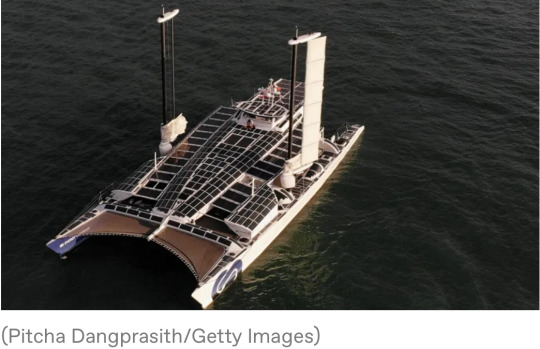
“For the past seven years, Energy Observer has traveled around the world, serving as a floating test bed for zero-emission technologies that can propel boats and ships — without spewing any of the nasty pollution that comes from running diesel engines. […] The project’s leaders say they’re now ready to focus their efforts on cleaning up much larger and dirtier types of vessels, including cargo ships.”
8. 1,000 oceanic manta rays seen in the Maldives
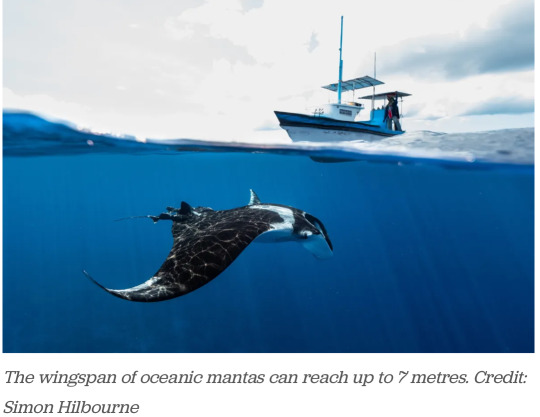
“With 1,000 individuals in its waters, the Maldives is home to the world’s third largest population of giant mantas (it also has the most reef mantas (Mobula alfredi) in the world, with over 5,000 individuals).”
9. Service Finalizes Land Protection Plan for Expanding Muleshoe National Wildlife Refuge

“Plan aims to deliver in-perpetuity conservation of up to 700,000 acres of land for benefit of migratory and resident wildlife. […] "These vast grassland landscapes provide essential habitat for wildlife while also providing benefits like clean water filtration and carbon sequestration, which are essential for both the environment and human well-being."”
10. Medicaid Officials Remove Barriers For Those With Disabilities

“In addition [to grace periods for submitting paperwork], states will no longer be allowed to conduct renewals any more than once every 12 months and they will be barred from requiring in-person interviews for people with disabilities, among other changes.”
And a bonus article to make up for posting late: Gay Furry Hackers strike again!
April 8-14 news here | (all credit for images and written material can be found at the source linked; I don’t claim credit for anything but curating.)
#hopepunk#good news#nature#ocean#climate#climate change#canada#australia#wildlife#lgbtq#lgbtqia#book#disability#employment#rehabilitation#disabled#accessibility#carbon#oil spill#cork#boat#renewableenergy#renewablefuture#solar energy#manta ray#fish and wildlife#birds#habitat#conservation#medicaid
14 notes
·
View notes
Text
Coal-fired power plants would be forced to capture smokestack emissions or shut down under a rule issued Thursday by the Environmental Protection Agency. New limits on greenhouse gas emissions from fossil fuel-fired electric plants are the Biden administration’s most ambitious effort yet to roll back planet-warming pollution from the power sector, the nation’s second-largest contributor to climate change. The rules are a key part of President Joe Biden’s pledge to eliminate carbon pollution from the electricity sector by 2035 and economy-wide by 2050. The rule was among four measures targeting coal and natural gas plants that the EPA said would provide “regulatory certainty” to the power industry and encourage them to make investments to transition “to a clean energy economy.” The measures include requirements to reduce toxic wastewater pollutants from coal-fired plants and to safely manage coal ash in unlined storage ponds. EPA Administrator Michael Regan said the rules will reduce pollution and improve public health while supporting the reliable, long-term supply of electricity that America needs.
14 notes
·
View notes
Text

Ottawa's combined sewage storage tunnel, seen here in a photo taken during construction, has given the city much more capacity to handle wastewater. But it has a limit. (City of Ottawa)
27 notes
·
View notes
Text
Preserving Assets: The Role of Corrosion Inhibitors in Industrial Maintenance
Corrosion is a persistent threat to industrial assets, causing billions of dollars in damages annually across various sectors. From oil and gas facilities to manufacturing plants, the impact of corrosion can be devastating, leading to equipment failures, production downtime, and costly repairs. However, with the right preventive measures in place, such as corrosion inhibitors, industrial facilities can effectively mitigate the risk of corrosion and prolong the lifespan of their assets. As a leading chemical company in Vadodara, Imperial Oilfield Chemicals Pvt. Ltd. (ICPL) understands the critical role of corrosion inhibitors in industrial maintenance. In this blog post, we'll explore the importance of corrosion inhibitors, their applications, and the expertise of ICPL as a corrosion inhibitor manufacturer and exporter in India.

Understanding Corrosion Inhibitors
Corrosion inhibitors are chemical compounds designed to protect metal surfaces from the damaging effects of corrosion. By forming a protective barrier on the metal surface or altering the corrosion process, inhibitors prevent or slow down the oxidation and deterioration of metals in corrosive environments. Corrosion inhibitors are widely used in various industries, including oil and gas, petrochemicals, power generation, water treatment, and manufacturing, to safeguard critical assets and infrastructure from corrosion-related failures.
The Importance of Corrosion Inhibitors in Industrial Maintenance
1. Asset Protection: Industrial facilities rely heavily on equipment and infrastructure made of metal, such as pipelines, tanks, vessels, and machinery. Corrosion inhibitors play a crucial role in protecting these assets from corrosion, extending their service life and reducing the need for frequent repairs or replacements.
2. Cost Savings: Corrosion-related failures can result in significant financial losses due to equipment downtime, production disruptions, and repair expenses. By incorporating corrosion inhibitors into maintenance programs, industries can minimize the risk of corrosion-related failures and realize substantial cost savings in the long run.
3. Safety and Reliability: Corrosion compromises the structural integrity of industrial assets, posing safety hazards to personnel and the surrounding environment. Corrosion inhibitors help maintain the reliability and safety of critical infrastructure, reducing the likelihood of accidents, spills, and environmental contamination.
4. Environmental Protection: Corrosion-related leaks and spills can have detrimental environmental consequences, polluting soil, water bodies, and ecosystems. By preventing corrosion and minimizing the risk of leaks and spills, corrosion inhibitors contribute to environmental protection and sustainability efforts.
Applications of Corrosion Inhibitors
Corrosion inhibitors find applications across various industrial sectors, where metal components are exposed to corrosive environments. Some common applications of corrosion inhibitors include:
Oil and Gas Production: In the oil and gas industry, corrosion inhibitors are used to protect pipelines, well casings, and production equipment from corrosion caused by corrosive fluids, gases, and environmental conditions.
Water Treatment: Corrosion inhibitors are added to cooling water systems, boilers, and wastewater treatment facilities to prevent metal corrosion caused by dissolved oxygen, scale formation, and aggressive ions.
Manufacturing: In manufacturing processes involving metal components, such as automotive, aerospace, and electronics manufacturing, corrosion inhibitors are used to protect parts, components, and machinery from corrosion during production, storage, and transportation.
Marine and Offshore Structures: Corrosion inhibitors are applied to marine vessels, offshore platforms, and coastal structures to protect against corrosion in seawater environments.
ICPL: Your Trusted Corrosion Inhibitor Manufacturer and Exporter in India
As the best chemical company in Vadodara, ICPL is dedicated to delivering high-quality corrosion inhibitors tailored to the specific needs of industrial clients. Here's why ICPL is the preferred choice for corrosion inhibitors in India:
Expertise and Experience: With decades of experience in the chemical industry, ICPL possesses the expertise and technical know-how to develop and manufacture corrosion inhibitors that meet the highest quality standards and regulatory requirements.
State-of-the-Art Facilities: ICPL operates state-of-the-art manufacturing facilities equipped with advanced technologies and production processes to ensure the consistent quality and performance of its corrosion inhibitors.
Customized Solutions: ICPL offers customized corrosion inhibitor formulations tailored to the unique requirements and operating conditions of industrial applications. Our team of experts works closely with clients to develop solutions that address specific corrosion challenges and performance objectives.
Global Reach: As a corrosion inhibitor exporter in India, ICPL serves clients worldwide, exporting its products to diverse markets across Asia, Africa, the Middle East, and beyond. With a strong global presence and distribution network, ICPL delivers reliable corrosion protection solutions to industries around the globe.
Conclusion
In conclusion, corrosion inhibitors play a crucial role in industrial maintenance by protecting metal assets from the damaging effects of corrosion. As a leading corrosion inhibitor manufacturer and exporter in India, ICPL is committed to providing high-quality corrosion inhibitors that safeguard critical infrastructure, ensure operational reliability, and promote cost-effective maintenance practices. With ICPL's expertise, customized solutions, and global reach, industries can effectively mitigate the risk of corrosion and preserve the integrity of their assets for years to come. Contact ICPL today to learn more about our corrosion inhibitor products and solutions.
#Corrosion inhibitor Vadodara#Best chemical company in Vadodara#Corrosion Inhibitor exporter in India#Corrosion inhibitors manufacturer in India#Oxygen scavenger Chemical in Vadodara#Oxygen scavenger Chemical supplier in Gujarat#Oxygen scavenger Chemical Manufacture India#Oxygen scavenger Chemical exporter in Gujarat#Oil and gas industry#Oil and gas companies#Oil and gas pipelines#leading Oilfield Chemicals manufacturer and exporter in India
7 notes
·
View notes
Text
Advanced Wastewater Processing Tanks in India: Reliable Solutions by MizuTanks
Efficient wastewater management is a critical need for industries and municipalities in India. MizuTanks specializes in providing high-quality wastewater processing tanks designed to meet the diverse needs of industries across the country. Our innovative solutions ensure seamless operation, durability, and compliance with environmental standards.
Why Choose Wastewater Processing Tanks?
Wastewater processing tanks play an essential role in treating and storing wastewater before it is discharged or reused. Whether for industrial or municipal applications, these tanks are designed to handle the complexities of wastewater storage and treatment with efficiency and reliability.
Features of MizuTanks’ Wastewater Solutions
Advanced Processing Tanks:
Our tanks are engineered to handle complex wastewater treatment processes with precision and efficiency.
Durable and Reliable:
MizuTanks uses premium-grade materials to manufacture robust and long-lasting industrial wastewater tanks in India.
Customizable Solutions:
We provide tailor-made wastewater storage tanks to meet the specific needs of different industries and projects.
Eco-Friendly Design:
Our tanks are designed to support sustainable wastewater management practices.
Applications of Wastewater Processing Tanks
Industrial Wastewater Management:
Industries across sectors like manufacturing, chemicals, and textiles benefit from industrial wastewater tanks in India that ensure effective treatment and storage.
Municipal Wastewater Solutions:
For cities and towns, Pune wastewater solutions by MizuTanks provide reliable infrastructure to manage wastewater efficiently.
Agricultural Use:
Treated wastewater stored in our tanks can be reused for irrigation, promoting sustainable agricultural practices.
Why MizuTanks Stands Out
Proven Expertise:
With years of experience, MizuTanks is a trusted provider of advanced processing tanks for wastewater solutions.
Comprehensive Support:
From consultation to installation, we offer end-to-end services tailored to your requirements.
Commitment to Quality:
Our wastewater processing tanks in India are built to last, ensuring maximum performance and value.
Sustainability Focus:
MizuTanks’ solutions help industries and municipalities adopt environmentally friendly wastewater practices.
MizuTanks: Your Partner for Wastewater Solutions
Based in Pune, MizuTanks is dedicated to providing advanced and reliable wastewater storage and treatment solutions. Our products meet the highest standards of quality, ensuring that your wastewater management system operates efficiently and sustainably.
Conclusion
Effective wastewater management is vital for industrial and environmental sustainability. MizuTanks offers cutting-edge wastewater processing tanks in India that cater to industries and municipalities alike. With our expertise and commitment to innovation, we deliver Pune wastewater solutions and beyond that exceed expectations.
Visit MizuTanks to learn more about our advanced wastewater storage and processing solutions and take the first step towards efficient wastewater management.
#Wastewater processing tanks in India#Mizutanks#industrial wastewater tanks in India#advanced processing tanks#wastewater storage#Pune wastewater solutions"
0 notes
Text
💧 Efficient Wastewater Storage Solutions in Pune & India 🌍
Looking for wastewater storage tanks in Pune? 🌊 COEP Prefab Water Tanks offers high-quality wastewater containment tanks in Pune designed for safe and efficient wastewater management. Our wastewater storage tanks in India are engineered to handle industrial and municipal wastewater, ensuring compliance with environmental regulations.
🌐 Visit Now: Wastewater Storage Tanks in Pune

✅ Why Choose Our Wastewater Storage Tanks?
🔹 Durable & Corrosion-Resistant – Our COEP wastewater storage solutions in India are built from top-quality materials for long-lasting performance. 🔹 Leak-Proof & Secure – Our wastewater storage tanks in Pune provide a robust containment system to prevent leakage and contamination. 🔹 Customizable for Various Needs – Available in different capacities, our wastewater containment tanks in Pune cater to industrial, commercial, and municipal applications. 🔹 Sustainable & Eco-Friendly – Designed for Effluent Treatment Plants tanks, these storage solutions support wastewater recycling and treatment.
🚀 Applications of Wastewater Storage Tanks
✔️ Industrial wastewater management 🏭 ✔️ Municipal sewage treatment systems 🌱 ✔️ Effluent storage in treatment plants 🏢 ✔️ Environmental and sustainability projects 🌎
As leading COEP wastewater tanks suppliers in Pune, we specialize in wastewater treatment storage tanks in Pune, ensuring efficiency and reliability in water treatment systems. Our efficient wastewater tanks in India are an essential part of sustainable water management strategies for industries across the country.
📞 Contact us today for high-performance wastewater storage tanks in India! 💧
🔗 Explore More
#WastewaterStorage #WastewaterTanks #EffluentTreatmentTanks #COEPPrefabWaterTanks #WaterManagement #EcoFriendlySolutions #StorageTanksIndia #WastewaterSolutions 🚰
#Waste water storage tanks#Wastewater storage tanks in Pune#Wastewater storage tanks in India#coepprefabwatertanks storage tanks in India#Wastewater containment tanks Pune#COEP wastewater tanks suppliers Pune#COEP wastewater storage solutions India#Wastewater treatment storage tanks Pune#Efficient wastewater tanks in India#Effluent Treatment Plants tank
0 notes
Text
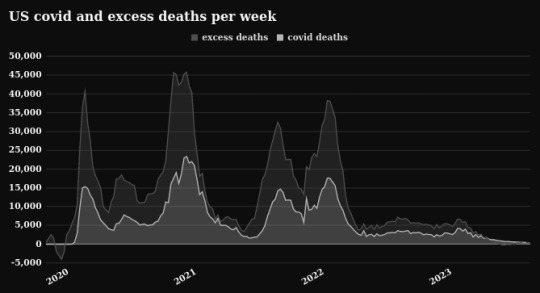
i haven't made a covid post for a while but there does seem to be another summer wave going on
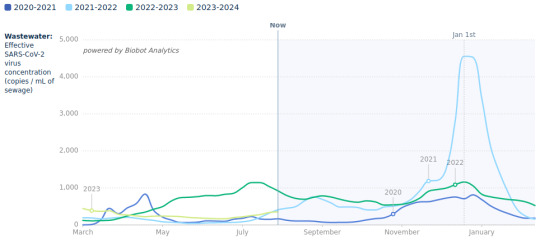
hospitalizations, wastewater, and positive tests are fairly similar to past years' summer waves (but not as bad as 2022). deaths remain lower than any other point during the pandemic, and excess deaths have returned to pre-pandemic levels (deaths are delayed compared to other variables, so whether it continues this way seems... fairly important)
excess deaths are as always a heinously complicated thing. i might be underestimating dec 2022 (i'm still estimating based on WHO 20-21 data, total deaths being about 2x reported deaths, weighted to a slightly higher multiple in weeks with more deaths and a lower multiple in weeks with fewer deaths) -- but we do seem to be in the first 2 or 3 week period of negative excess deaths since, uh, the very first week of lockdowns (which, if you recall, may have prevented a small but noticeable number of other preventable deaths). this could be underreported and subject to later updates, but the margin is small and the updates don't usually change the numbers too much. you can't really underreport a severe spike, when that happens we start talking about refrigerated morgue storage trucks and mass graves
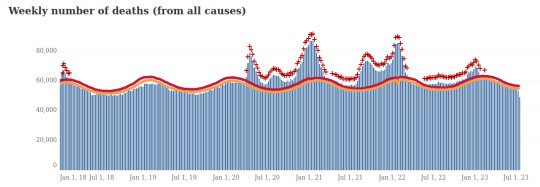
CDC's estimate of excess deaths. i'm also mixing CDC's reported deaths for the 2023 with johns hopkins data from prior years, because JH ceased reporting and i didn't want to rebuild a spreadsheet that was never terribly precise to begin with (it's intended to help me to chart uncharted waters, or gauge whether what they're saying in the news really matches the available data, which... mostly it does but you know there's a tendency to downplay it)
recent research shows that the original variant killed 3 of 4 types of brain cells (pericyte, endothelial, and microglia), while other variants killed fewer types of brain cells. that said, i don't want to downplay that all variants still have potentially deleterious effects on the brain. it does seem that newer variants are losing potency, but this is not necessarily a linear progression, as omicron killed two types of brain cells while alpha and beta only killed one type. this is, of course, in addition to microclotting, cytokine storms, and fused neurons, each of which have deleterious effects in the brain as well as the rest of the body (although the fused neuron study was observed in a petri dish and not in vivo)
so... it appears to be substantially less lethal at the moment, this does not mean it can't regain potency in the future, but in any case you still don't want to catch it and it is presently circulating
22 notes
·
View notes
Text
Excerpt from this story from Inside Climate News:
Every Friday afternoon, the Kingsland Wildflower Green Roof opens its doors to the local community. Tall grass and brightly-colored flowers greet visitors after their four-floor trek to the top of the building—a green oasis in Brooklyn, surrounded on all sides by heavy industrial activity.
Just across the street, the Newtown Creek Wastewater Treatment Plant’s gargantuan “digester eggs” treat millions of gallons of sewage every day.
Despite the visual incongruity of this scene, both the garden and the treatment plant work to stop contaminated water from flowing into the city’s waterways during heavy rainfall.
The rooftop garden sits on a building on Kingsland Avenue owned by the production company Broadway Stages. Two well-tended sections contain a variety of plants and flowers native to the area, like strawberries and camassias. A garden on a lower roof is made up largely of sedum, a small succulent-type plant.
The garden is under the purview of the Newtown Creek Alliance, a local organization that works to improve the environment around the creek, which is a tributary of the East River and forms the border between Brooklyn and Queens.
Seven years ago, the green roof was born of a partnership between the Newtown Creek Alliance, the NYC Bird Alliance, formerly NYC Audubon, Broadway Stages and Alive Structures, a landscaping firm that specializes in roof gardens. The installation was funded by the Greenpoint Community Environmental Fund, a $19.5 million payment to the New York State Department of Conservation (NYSDEC) in a settlement with ExxonMobil over their contamination of Newtown Creek.
In 1979, an investigation by the Department of Conservation found that ExxonMobil, which had historically operated oil refineries and fuel storage spaces along the creek, had spilled an estimated 17 million gallons of oil into the water—one of the largest terrestrial oil spills in the country’s history. Although ExxonMobil has been working for decades to remediate the problem through groundwater treatment, the creek remains an extremely contaminated Superfund site and is still on the National Priorities List of the nation’s most hazardous toxic waste areas.
A former wetland, much of the creek’s natural borders have been reconstructed for industrial operations, like oil refineries and petrochemical plants.
Much of the area surrounding Newtown Creek is located on a 100-year floodplain, which means that every year there is a 1 percent chance of an extreme flood event. Due to the weaknesses in New York’s sewage infrastructure, extreme rainfall constitutes a threat not just to the residents living near Newtown Creek, but also to the biodiversity within the creek and the flora that surrounds it.
4 notes
·
View notes
Text
just stayed with my friends who are a trained chef and a professor of wastewater microbiology who researches the breakdown of novel ww contaminants. can report they have an absolutely massive stash of plastic takeout and deli containers they reuse for food prep and storage
8 notes
·
View notes